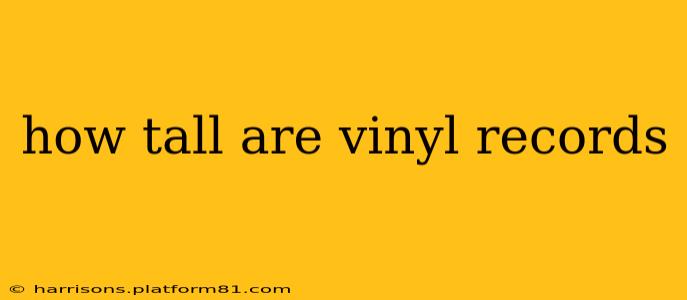Vinyl records, those nostalgic circles of sound, come in a variety of sizes, each with its own unique dimensions. While the term "height" isn't typically used to describe a record's physical attributes, we can discuss the thickness and overall dimensions, addressing the common queries surrounding their size. This comprehensive guide will clarify the specifics and answer some frequently asked questions.
What are the standard dimensions of a vinyl record?
The most common type of vinyl record is the 12-inch LP (long-playing record). These typically measure approximately 12 inches (30.5 cm) in diameter. However, the thickness is where things get a little more nuanced. A standard 12-inch vinyl record is usually around 1/16th of an inch (1.5mm) thick, though this can vary slightly depending on the manufacturer and the specific pressing.
We also have other sizes to consider:
-
7-inch singles: These smaller records are typically around 7 inches (17.8 cm) in diameter and share the same approximate thickness as 12-inch LPs.
-
10-inch records: A less common size, but still encountered, the 10-inch record sits between the 7-inch and 12-inch formats, with the same general thickness.
What about the packaging? How tall is the whole thing?
When considering the overall "height" of a vinyl record, you need to factor in the sleeve. A 12-inch LP housed in its standard jacket will typically measure around 12 inches wide, 12 inches tall, and about 0.25 to 0.5 inches thick (depending on the jacket type and if it contains inner sleeves). The 7-inch singles will have smaller dimensions accordingly. Keep in mind that gatefold sleeves (those that open like a book) will add to the overall height when opened.
How does the thickness of a vinyl record impact its sound quality?
While the thickness itself doesn't directly determine sound quality, it plays an indirect role. Thicker vinyl, generally considered higher quality, can offer improved stability and reduced surface noise, potentially resulting in a slightly clearer and more dynamic listening experience. However, the mastering, pressing, and overall condition of the record significantly impact sound quality far more than thickness alone.
Are there different thicknesses of vinyl records?
Yes, there are variations in thickness. While the standard is around 1/16th of an inch, some high-end or special edition pressings might use thicker vinyl for improved durability and sound quality. Conversely, budget pressings might use slightly thinner vinyl. But these differences are subtle and often not noticeable to the casual listener.
What materials are used to make vinyl records?
Vinyl records are primarily made from polyvinyl chloride (PVC), a type of plastic. However, different formulations of PVC are used, and some manufacturers might incorporate additives to enhance the record's properties (durability, flexibility etc.).
Do all vinyl records have the same thickness?
No, while there's a standard thickness, there are variations depending on the manufacturer, the pressing method, and the overall quality of the record. The differences are usually small, but collectors and audiophiles often notice these discrepancies. These minor differences are unlikely to impact how a record plays.
This detailed breakdown should provide a comprehensive understanding of the dimensions of vinyl records, addressing their various sizes and thicknesses and putting to rest any confusion surrounding their size. Remember to always handle your vinyl records with care to ensure they last for years to come and continue to provide your favorite music.
